
Architecture and Technology of the Electric Vehicle
pertes énergétiques d'un V.E. sur cycle autoroutier (FUDs Highway)
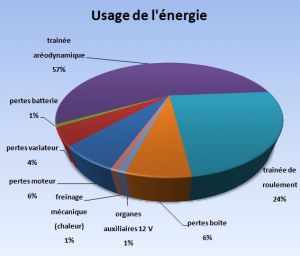
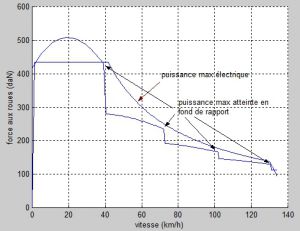
Poussée aux roues en fonction de la vitesse
Cartographie d'isorendements
du Groupe Motopropulseur
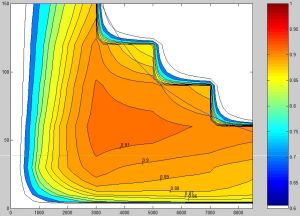
Dynamic performance.
A power equal to a thermal vehicle, the electric vehicle operates optimally maximum power, with the exception of the first speed ratio in which the force to the vehicle wheels is greater heat. For completeness, we must also consider the fact that no shift is performed with the electric vehicle.
Conclusion: the rise time is much lower speed with an electric vehicle: 0-100 in 10 seconds for a vehicle of 1100kg / 75 hp electric (12.2S for a clio 1.5 dci 80 hp).
Efficiency of the Powertrain (Synchronous motor + inverter)
Unlike a combustion engine, for which the return is capped at 30%, and varies over a wide range of operating points, the electrical performance of a Powertrain (inverter + motor), is greater than 90% over a wide range of use. The relatively short range of electric vehicles is primarily due to the limited amount of onboard power: 30 kW.h, corresponding to potentially ... 3 liters of fuel.
Nevertheless, taking into account the low performance of the engine (25-28%), this amount of energy embedded kW.h 30 corresponds to around 10 liters of fuel. we now understand better why hunting is important to energy ...
The second point to understand is that the VE is able to recharge its batteries under décéralion or descent. Added to the fact that the performance of GMP remains efficient at low speeds (90%), the equivalent petrol 10l allow to go far in the urban cycle. In this case, it is realistic enough to announce a range of 200km.
The heat medium that remains in the lower gears, and sees its performance drop transient, in that case has a relatively high consumption.
Complete record.
Energy losses of the electric vehicle
On a motorway journey, constant speed, the EV is losing its advantage in city driving:
- Little or no energy recovery during deceleration.
- Proportion of aerodynamic drag (CdA = 0.99 on the graph against).
In this case the 10l fuel equivalent may be felt. While the EV can travel 200 km in city driving, this autonomy may drop to cycle 80km on motorways (130 km / h for example).
Consequences :
- Electric Vehicle use is restricted to travel in urban and peri-urban. The range of 150 km will be advanced by the manufacturers in this case respected. But beware of disappointments at high speed.
- Manufacturers must treat CdA (coefficient of aerodynamic drag) to maintain independence as far as possible. This point seems to have been observed in the design of the Renault Fluence ZE and ZOE.
For more information, the thesis of JC Papazian "Optimisation de la chaîne de traction d'un véhicule électrique".
Setting up of the battery under the frame
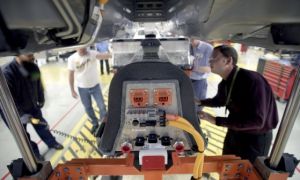
Chevrolet volt electric vehicle frame with a range extender
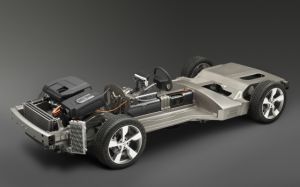
General structure of the vehicle.
The first mass produced electric vehicles will resume partially "conventional" architecture of combustion vehicles, including motor, gearbox and drive train (classic). At this level, two major differences:
- The gear box has a fixed ratio, approximately equivalent to the ratio of a second speed.
- The engine is in direct transmission: no clutch.
Thus, an engine that runs from 0 to 10 000 t / min will cause the vehicle from 0 to 130 km / h (136 km / h meter).
However, the whole powertrain is more compact (5 times more potent per unit mass) in regard of an internal combustion engine.
Traction battery.
The traction battery contains the whole on-board energy of the vehicle . Its capacity ranges from 15 to 30 kW.h approximately, which corresponds to a range of 100 to 250 km depending of the vehicle and the driving cycle performed. Its mass, which is around 300kg, allows a low center of gravity, thus improving its handling. Its shape is adapted to the chassis (see Chevy Volt).
In case of short circuit following an incident, the battery could cause an incident similar to the explosion of a fuel tank (30kW.h corresponds to the internal energy of 13''. The fuel). Complete record. More information.

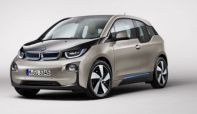

Electric and hybrid vehicules technology
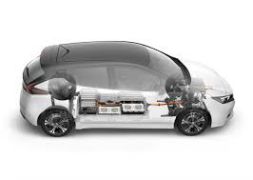
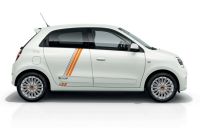
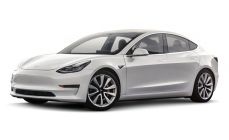


Réalisations